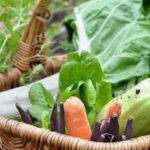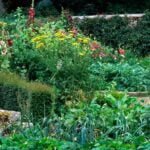Have you ever wondered, is 7 dust safe for vegetable gardens? Many gardeners use 7 Dust as a pesticide to control pests in their vegetable gardens, but there are concerns about its safety. In this article, we will explore the composition and potential risks of using 7 Dust in vegetable gardens, as well as alternative pest control methods and research findings on its safety. Additionally, we will provide best practices and environmental considerations for using 7 Dust in vegetable gardens.
When it comes to gardening, pest control is essential to ensure a healthy and thriving vegetable garden. One common product used for pest control is 7 Dust. However, there are questions surrounding the safety of using this pesticide in vegetable gardens. It’s important to understand what exactly 7 Dust is and its purpose in vegetable gardens before determining whether it is safe or not.
In this section of the article, we will address these concerns and provide an overview of what 7 Dust is and why it is used in vegetable gardens. Additionally, we will delve into the potential risks associated with using 7 Dust, including harm to the environment and non-target organisms, as well as potential health risks to humans, pets and beneficial insects.
Understanding 7 Dust
7 Dust, also known as Sevin Dust, is a widely used insecticide in vegetable gardens to control pests such as aphids, beetles, and caterpillars. It is a contact insecticide that kills insects upon contact and provides residual control of up to several weeks. The active ingredient in 7 Dust is carbaryl, a chemical compound that disrupts the nervous system of insects, ultimately leading to their death. This makes 7 Dust an effective method for pest control in vegetable gardens.
The concern about whether 7 dust is safe for vegetable gardens is often raised due to its chemical composition and potential risks associated with its use. Carbaryl, the active ingredient in 7 Dust, is classified as a likely human carcinogen by the United States Environmental Protection Agency (EPA).
In addition to potential health risks for humans and pets, the broad-spectrum nature of carbaryl means that it can harm non-target organisms such as beneficial insects and pollinators. Therefore, it is essential for gardeners to weigh the benefits of using 7 Dust against its potential risks when considering pest control options in their vegetable gardens.
When using 7 Dust in vegetable gardens, it’s crucial to follow safety guidelines and take precautions to minimize its impact on the environment and non-target organisms. This includes using protective gear while applying 7 Dust, avoiding application during windy conditions to prevent drift, and adhering to recommended dosage rates. Additionally, considering alternative pest control methods and practicing integrated pest management can help reduce reliance on chemical insecticides like 7 Dust while maintaining healthy vegetable gardens.
| Benefits of Using 7 Dust | Potential Risks of Using 7 Dust |
|---|---|
| Effective at controlling a wide range of pests | Potential harm to beneficial insects |
| Provides residual control for several weeks | Classified as a likely human carcinogen by EPA |
| Convenient application method | May pose health risks to humans and pets |
Potential Risks of Using 7 Dust in Vegetable Gardens
7 Dust is a common insecticide used in vegetable gardens to control pests and protect crops. However, there are concerns about the safety of using 7 Dust in vegetable gardens, particularly regarding its potential risks to the environment, non-target organisms, and human health. It is essential for gardeners to understand these potential risks before using 7 Dust in their vegetable gardens.
One of the primary concerns about using 7 Dust in vegetable gardens is its impact on non-target organisms and beneficial insects. The chemicals in 7 Dust can harm bees, butterflies, and other pollinators that are essential for the successful growth of vegetables. Additionally, birds and other wildlife may also be affected if they ingest insects or plants that have come into contact with 7 Dust.
Another potential risk of using 7 Dust in vegetable gardens is the impact on human health. Exposure to the chemicals in 7 Dust can pose a risk to gardeners, their families, and pets. Inhaling or ingesting the particles or coming into direct contact with the skin can lead to adverse health effects. Therefore, it is crucial for gardeners to take proper precautions when using 7 Dust and consider alternative pest control methods that are safer for humans and animals.
Moreover, there is a concern about the environmental impact of using 7 dust in vegetable gardens. The chemicals in this insecticide can leach into the soil and potentially contaminate groundwater. This can have long-term effects on soil quality and overall ecosystem health. Additionally, repeated use of 7 dust may lead to pest resistance and negatively impact plant health over time. Considering these potential risks is essential for making informed decisions about pest control in vegetable gardens.
- Using protective gear such as gloves, masks, and goggles when applying 7 Dust
- Applying 7 Dust only when necessary in targeted areas rather than across the entire garden
- Using lower concentrations or alternate pest control methods whenever possible
- Regularly monitoring for pests to catch infestations early
- Following specific guidelines from manufacturers for disposal of unused product
By being mindful of these potential risks and following best practices for using 7 Dust,is important for maintaining a healthy environment while effectively controlling pests in vegetable gardens.
Alternative Pest Control Methods for Vegetable Gardens
There are alternative pest control methods that gardeners can consider using in place of 7 Dust for their vegetable gardens. These methods provide effective pest control without posing potential risks to the environment, non-target organisms, and human health. Additionally, these alternatives promote sustainable gardening practices and support the overall health of the garden ecosystem.
Organic Pest Control Methods
One alternative to using 7 Dust in vegetable gardens is organic pest control methods. This includes the use of natural predators, such as ladybugs and praying mantises, to control pest populations. Additionally, employing companion planting techniques, using insecticidal soaps and neem oil, and practicing crop rotation can help manage pests without the need for chemical pesticides.
Non-Toxic Pest Control Methods
Non-toxic pest control methods are also viable alternatives to 7 Dust. These methods involve physical barriers like row covers or netting to protect crops from pests. Additionally, employing traps and pheromone-based lures can help monitor and control pest populations without resorting to chemical pesticides.
Integrated Pest Management
Another approach that gardeners can take is integrated pest management (IPM). This method focuses on using a combination of cultural, biological, and mechanical controls to manage pests in vegetable gardens. By implementing a variety of strategies such as maintaining soil health, promoting biodiversity, and practicing good sanitation and hygiene in the garden, gardeners can effectively minimize pest damage while minimizing the need for chemical pesticides.
Overall, considering these alternative pest control methods provides gardeners with a range of options for managing pests in their vegetable gardens while minimizing potential risks associated with the use of 7 Dust. By adopting these methods, gardeners can contribute to a healthier garden ecosystem and ensure the safety of their produce for consumption.
Research Findings on the Safety of 7 Dust in Vegetable Gardens
When considering whether 7 Dust is safe for vegetable gardens, it is important to take into account research findings on the topic. Scientific studies have been conducted to evaluate the effects of 7 Dust on both plants and the environment. Here are some key research findings related to the safety of using 7 Dust in vegetable gardens:
- A study published in the Journal of Economic Entomology found that 7 Dust effectively controls pests such as aphids, caterpillars, and beetles in vegetable gardens. The research concluded that when used according to label instructions, 7 Dust is an efficient pest control method with minimal impact on plant health.
- Another study from the Environmental Science & Technology journal evaluated the environmental impact of 7 Dust on soil and water quality. The research indicated that while 7 Dust can persist in the environment, its impact on non-target organisms and water sources is limited when applied properly and in moderation.
- Research from the National Institute of Environmental Health Sciences has also looked into the potential health risks of using 7 Dust in vegetable gardens. The findings suggest that direct exposure to large amounts of 7 Dust may pose a risk to humans and pets. Therefore, it is crucial for gardeners to follow safety precautions when using this pest control product.
It is important for gardeners to consider these research findings when deciding whether to use 7 Dust in their vegetable gardens. While it can be an effective pest control method, it is essential to use it responsibly and carefully to minimize any potential risks. Additionally, staying informed about new research developments regarding the safety of 7 Dust is crucial for making well-informed decisions about its use in vegetable gardens.
Best Practices for Using 7 Dust in Vegetable Gardens
When using 7 Dust in vegetable gardens, it is essential to follow best practices to ensure the safety of your plants, the environment, and yourself. First and foremost, always read and follow the instructions provided on the product label.
This will include important information about application methods, dosage, and safety precautions. It is crucial to wear protective gear such as gloves, long-sleeved shirts, pants, and a mask while applying 7 Dust to avoid direct contact with the skin or inhalation of the product.
Another best practice for using 7 Dust in vegetable gardens is to apply it during the early morning or late evening when pollinators are less active. This helps minimize the risk of harming beneficial insects such as bees that are crucial for pollination. Additionally, avoid applying 7 Dust on windy days to prevent the product from dispersing beyond the intended area and affecting non-target organisms.
Proper storage of 7 Dust is also important for ensuring its effectiveness and safety. Store the product in its original container in a cool, dry place away from food, pet supplies, and children’s reach. This will prevent accidental ingestion or exposure to 7 Dust. By following these best practices for using 7 Dust in vegetable gardens, gardeners can effectively manage pests while minimizing potential risks to their garden ecosystem.
Considering the Environmental Impact of Using 7 Dust in Vegetable Gardens
When considering the use of 7 Dust in vegetable gardens, it is important to take into account the potential environmental impact of this pesticide. While 7 Dust can be effective in controlling pests that can damage vegetable crops, there are concerns about its impact on the surrounding environment.
It is crucial for gardeners to understand the potential long-term effects of using 7 Dust on soil and water quality, as well as its impact on beneficial organisms and overall plant health.
Effects on Soil and Water Quality
One of the main concerns about using 7 Dust in vegetable gardens is its potential impact on soil and water quality. The active ingredients in 7 Dust can leach into the soil and runoff into nearby water sources, leading to contamination. This can have detrimental effects on not only the immediate garden area but also the surrounding ecosystem. Gardeners should consider alternative pest control methods that do not pose a threat to soil and water quality.
Impact on Beneficial Organisms and Plant Health
In addition to its potential effects on soil and water, 7 Dust may also harm beneficial organisms such as bees, butterflies, earthworms, and other insects necessary for pollination and natural pest control. Furthermore, excessive use of 7 Dust can lead to issues such as pesticide resistance in pests, which could ultimately exacerbate pest problems in vegetable gardens.
Considering these factors, it is essential for gardeners to weigh the benefits of using 7 Dust against its potential harm to beneficial organisms and overall plant health.
Adopting Sustainable Practices
To minimize the environmental impact of using 7 Dust in vegetable gardens, gardeners should adopt sustainable practices when managing pest control. This may include implementing integrated pest management strategies that prioritize non-toxic or organic methods first before resorting to chemical pesticides like 7 Dust. By reducing reliance on chemical pesticides, gardeners can help maintain a healthier and more balanced ecosystem within their vegetable gardens.
Conclusion
In conclusion, the use of 7 Dust in vegetable gardens is a topic of concern for many gardeners. While 7 Dust can effectively control pests and protect vegetable crops, there are also potential risks associated with its use.
The composition of 7 Dust and how it works to manage pests have been thoroughly explained, shedding light on its impact on the environment and non-target organisms. Additionally, the potential health risks to humans, pets, and beneficial insects have been discussed to provide a comprehensive understanding of the topic.
It is important for gardeners to consider alternative pest control methods that are organic and non-toxic in order to minimize the potential harm caused by chemical pesticides like 7 Dust. Integrated pest management practices offer valuable tips for maintaining a balance between pest control and environmental safety in vegetable gardens.
Research findings on the safety of 7 Dust have provided insight into its effects on soil quality, water quality, and beneficial organisms, giving gardeners a clearer perspective on its overall impact.
In light of these considerations, it is recommended that gardeners exercise caution when using 7 Dust in vegetable gardens. Following best practices for application and dosage can help minimize environmental impact and reduce potential health risks.
It is also advisable to stay updated with reliable sources of information on pesticide safety in order to make well-informed decisions for sustainable gardening practices. Ultimately, the decision to use 7 Dust or any chemical pesticide should be made with careful consideration of its potential benefits and risks in vegetable gardens.
Frequently Asked Questions
Is It Safe to Eat Vegetables Treated With Sevin Dust?
It is generally not recommended to eat vegetables treated with Sevin Dust. This pesticide contains harmful chemicals that can be toxic if ingested, and it’s important to thoroughly wash any produce treated with it.
Is It OK to Put Seven Dust on Tomato Plants?
While some gardeners use Sevin Dust on tomato plants to combat pests, it’s important to use caution. The chemicals in Sevin Dust can potentially harm the plant, as well as beneficial insects like bees.
Why Was Sevin Dust Banned?
Sevin Dust was banned for indoor residential use in 1988 due to concerns about its potential health effects on humans. The pesticide has been associated with a range of health issues, leading to restrictions on its use in certain settings.

If you’re looking to get into vegetable gardening, or are just looking for some tips on how to make your current garden better, then you’ve come to the right place! My name is Ethel and I have been gardening for years. In this blog, I’m going to share with you some of my best tips on how to create a successful vegetable garden.





